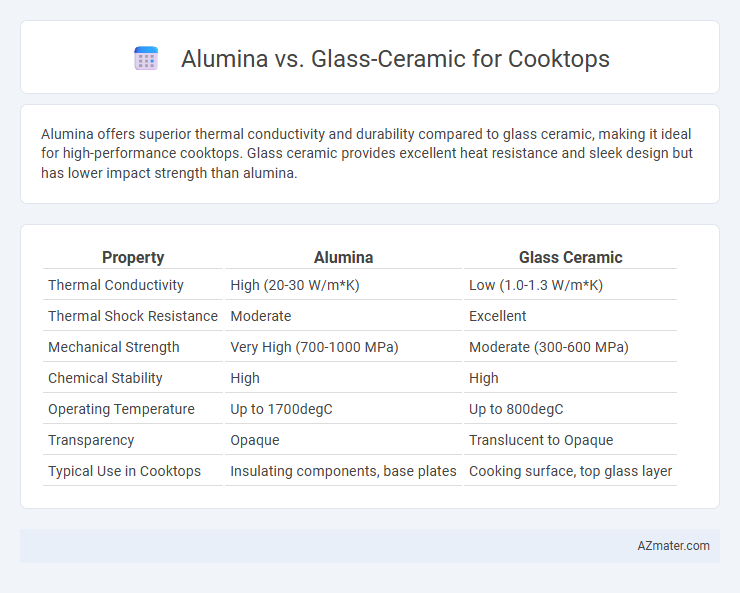Alumina offers superior thermal conductivity and durability compared to glass ceramic, making it ideal for high-performance cooktops. Glass ceramic provides excellent heat resistance and sleek design but has lower impact strength than alumina.
Table of Comparison
| Property | Alumina | Glass Ceramic |
|---|---|---|
| Thermal Conductivity | High (20-30 W/m*K) | Low (1.0-1.3 W/m*K) |
| Thermal Shock Resistance | Moderate | Excellent |
| Mechanical Strength | Very High (700-1000 MPa) | Moderate (300-600 MPa) |
| Chemical Stability | High | High |
| Operating Temperature | Up to 1700degC | Up to 800degC |
| Transparency | Opaque | Translucent to Opaque |
| Typical Use in Cooktops | Insulating components, base plates | Cooking surface, top glass layer |
Introduction: Choosing the Right Cooktop Material
Alumina offers superior thermal conductivity and exceptional resistance to thermal shock, making it an ideal choice for cooktops requiring rapid heat changes. Glass ceramic cooktops provide a sleek, smooth surface with excellent heat resistance and uniform heat distribution, enhancing both functionality and aesthetic appeal. Selecting between alumina and glass ceramic depends on the balance between durability, heat performance, and style preferences in kitchen appliances.
What is Alumina?
Alumina, or aluminum oxide, is a highly durable ceramic material used in cooktops for its exceptional thermal conductivity and resistance to high temperatures. Compared to glass ceramic, alumina offers superior hardness and scratch resistance, ensuring better longevity and performance under intense cooking conditions. Its excellent electrical insulating properties make it a reliable choice for advanced induction cooktop surfaces.
What Are Glass Ceramics?
Glass ceramics are engineered materials designed to combine the transparency and smooth surface of glass with the strength, thermal stability, and thermal shock resistance of ceramics, making them ideal for cooktops. They are composed of crystalline phases embedded within a glass matrix, offering superb heat resistance and even heat distribution for efficient cooking. Unlike alumina, glass ceramics provide enhanced durability against thermal stress and can withstand sudden temperature changes without cracking, ensuring longer-lasting cooktop performance.
Heat Resistance Comparison
Alumina cooktops exhibit superior heat resistance, maintaining structural integrity at temperatures exceeding 1,700degC, which makes them ideal for high-heat cooking environments. Glass ceramic cooktops, while offering excellent thermal shock resistance and rapid heat transfer, generally withstand temperatures up to around 1,200degC before softening or warping. The higher melting point and thermal stability of alumina ensure better durability and long-term performance under intense cooking conditions compared to glass ceramic.
Thermal Conductivity Differences
Alumina exhibits significantly higher thermal conductivity, typically around 30 W/m*K, allowing rapid heat transfer and efficient cooking performance in cooktops. Glass ceramic, with thermal conductivity approximately 1.5 W/m*K, offers slower heat distribution but excels in thermal shock resistance and insulation. These conductivity differences impact heat-up times and temperature control, influencing energy efficiency and user experience in cooktop applications.
Durability and Strength
Alumina exhibits superior durability and strength compared to glass ceramic, with a higher resistance to thermal shock and mechanical wear, making it ideal for high-impact cooking environments. Glass ceramic offers excellent heat resistance and smooth surface finish but is more susceptible to cracking under sudden temperature changes or heavy impact. For applications requiring maximum toughness and long-lasting performance, alumina is the preferred material for cooktops due to its enhanced structural integrity.
Scratch and Stain Resistance
Alumina cooktops exhibit superior scratch resistance due to their high hardness, making them less susceptible to surface abrasions compared to glass ceramic. Glass ceramic cooktops offer moderate stain resistance but can be prone to discoloration from acidic spills if not cleaned promptly. The alumina material's dense structure enhances durability against everyday kitchen wear, providing a longer-lasting, pristine appearance.
Aesthetic and Design Options
Alumina cooktops offer a sleek, glossy finish with limited color options, primarily in black or white, emphasizing durability and a modern minimalist aesthetic. Glass ceramic cooktops provide greater design versatility, featuring customizable patterns, colors, and textures that enhance kitchen style and blend seamlessly with various interior themes. The smooth, reflective surface of glass ceramic also contributes to a more elegant and contemporary look compared to the matte or semi-gloss finish of alumina.
Cost and Availability
Alumina cooktops typically offer a more cost-effective solution compared to glass ceramic options, with prices often lower due to simpler manufacturing processes and abundant raw materials. Glass ceramic cooktops, while more expensive, provide enhanced aesthetic appeal and better heat resistance but may face limited availability in certain markets due to specialized production requirements. Cost-efficiency and widespread availability make alumina a preferred choice for budget-conscious consumers, whereas glass ceramics cater to premium segment demands.
Conclusion: Which Material Suits Your Kitchen Best?
Alumina cooktops offer superior thermal conductivity and durability, making them ideal for high-heat cooking and heavy daily use. Glass ceramic cooktops provide sleek aesthetics and easier cleaning, appealing to kitchens prioritizing style and convenience. Choosing between alumina and glass ceramic depends on whether performance and longevity or appearance and maintenance are your primary kitchen needs.

Infographic: Alumina vs Glass ceramic for Cooktop
 azmater.com
azmater.com